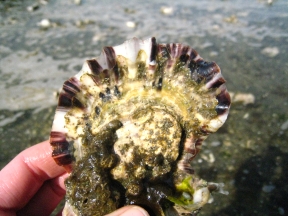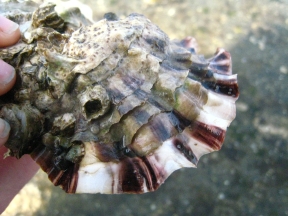Apr 10, 2008: Oyster Conformation

The oyster above was one of three dozen in a package we shipped to California yesterday. In our humble opinion, April is the friendliest oyster month: the water is still cold enough so that the oyster meat is really firm, but it's starting to warm up just enough to let them feed and grow.
These are amazingly beautiful, right? Even to people who aren't obsessed with oysters?
Oysters can get long and skinny when they're grown too close together, and so grow upright like trees in order to access more nutrients. They don't necessarily taste worse than a cup-shaped oyster, but they're definitely more difficult to eat raw.
Samson Von Puddly illustrating poor oyster conformation.




7 comments
I am completely obsessed with this amazing blog, and about to go buy some oysters from your store, or maybe (to save on shipping) wait until you arrive at the farmer’s markets. Thank you SO much for this! I have grown up on these cold beaches and now live in Seattle, and I forgot all about moon snails until your post on this. Ah, memories. Please keep up the amazing work, both the farming AND the writing!
Thanks! Writing the blog has helped us rediscover the delights of the tideflats, too. Unfortunately we don’t have plans to start selling at a farmer’s market anytime soon… it’s definitely something we should do, and we want to do it, but we have staffing issues. You can find Hama Hama Oysters at Metropolitan Markets throughout Puget Sound, as well as at University Seafood and Fresh Fish, in Seattle. We deliver to Seattle on Wednesdays. Thanks for your feedback!
[…] The bags roll around in the current when the tide comes in. They serve two purposes: they protect the fragile oyster seed from predators, and they tumble the new growth off of the oysters, encouraging them to develop a deeper cup and more desirable shape. […]
[…] our earlier post about oyster conformation here). Share on […]
[…] Blue Pools are either grown from seed on the Hama Hama estuary or nursed in Puget Sound and then finished in our tumble farm, which is located far from the mouth of the river, on deep tideland that has been fallow for some time. In this location, the oysters are close enough to the river delta to retain the clean, crisp taste of a Hama Hama, but far enough from the fresh water to raise the salinity in the liquor and help balance the sweet finish. Perfectly shaped with a velvety brininess, crunchy texture and smooth vegetable finish, Blue Pools offer the definitive raw oyster experience. (Read our earlier post about oyster conformation). […]